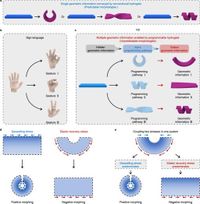In an era where information security is paramount, researchers have unveiled a novel method combining the principles of sign language with advanced hydrogel technology to enhance secure optical communication. This innovative strategy features a hydrogel that not only carries encrypted optical information but also demonstrates programmable geometric transformations, offering a sophisticated means of transmitting and protecting sensitive messages.
The research, published in Nature Communications, introduces a thermo-responsive P(NIPAm-co-Tpy) hydrogel capable of performing 4D morphing, whereby its shapes evolve over time, adding a dynamic dimension to previously static encryption methods. The hydrogel's design integrates specific polymer chain orientations that dictate its shape-morphing capabilities, enabling the material to bend or flatten in response to environmental stimuli.
At the heart of this development is the hydrogel's ability to gate optical information based on its geometric features. This means that the correct permutation of encrypted data can only be decoded when specific geometric transformations occur, enhancing the security of the information stored within. The integration of these mechanical properties is a significant step forward in the field of anti-counterfeiting technologies, particularly as they apply to food security, information storage, and communication systems.
The hybrid system was engineered via a thermo-initiated copolymerization of N-isopropyl acrylamide (NIPAm) and terpyridine-containing acrylate (Tpy-A). Tests showed that the hydrogel made with 5 wt% Tpy-A and 1 wt% N,N’-methylenebisacrylamide (BIS) successfully executed this complex morphing behavior. Furthermore, a wet filter paper soaked in a 0.1 M Fe3+ solution was utilized to program specific shapes into the hydrogel, thus verifying the information contained within as it bends from angles of 150° to 10° in as little as 30 seconds. In contrast, another variant made through photopolymerization displayed a negative morphing from 60° to 170° in a mere 16 seconds.
This unique approach effectively diverges from traditional optical encryption systems, which typically reveal information using predictable light properties. Instead, the hydrogel's multi-morph behavior means information retrieval relies on both geometric characteristics and optical manifesting, making unauthorized decryption significantly more complex.
The research team also illustrated how different synthesis parameters, such as varying BIS content, could shift the hydrogel's morphing direction. By tweaking the setup, they found that the thermo-initiated hydrogel underwent negative morphing at a lower BIS concentration and transitioned to positive morphing as the conditions changed. This adaptability could prove essential for crafting materials that can seamlessly adjust and respond to different environments or security needs.
Additionally, the team explored the integration of fluorescent materials into the hydrogel, demonstrating its capacity for multi-color output. By treating it with different solutions of rare earth metals like Eu3+ and Tb3+, researchers were able to create hydrogels that switch colors under UV light, enabling the generation of intricate patterns and luminescent indicators. These visual elements can further complicate decryption attempts, as unauthorized users would have to not only interpret the shape but also the color changes under various lighting conditions.
The significance of this dual-channel encryption system extends beyond mere novelty; it presents a sound alternative to existing technologies that rely heavily on single optical channels. The variable nature of the hydrogels’ shape not only provides additional layers of security but also increases the amount of information that can be stored within a given segment of material. For instance, the researchers encoded the letters “♥HEART” onto the hydrogel's surface and transformed its shape, effectively using geometry for information verification.
Moreover, the combination of optical encryption via luminescent patterns and complex shape morphing contributes to a higher security level. This dual encryption mechanism requires potential breachers to decipher both the geometric and optical codes, making unauthorized access exponentially more difficult.
The versatility of these programmable materials also paves the way for future applications in various fields requiring robust security measures. From safeguarding sensitive communications to enhancing authentication methods in products and services, this hydrogel technology is poised to revolutionize the landscape of secure information transfer.
However, the technology isn't without its limitations. The researchers note that the precision required for achieving complex shape-morphing capabilities hinges on the consistent application of their programming techniques, particularly in maintaining the resolution of the ion printing process used to create specialized shapes.
In conclusion, the integration of programmable 4D morphing hydrogels into the realm of optical communication represents a groundbreaking approach to secure information management. By marrying the physical form changes of the hydrogel with encrypted optical displays, this research could set the standard for future developments in anti-counterfeiting and secure communications, heralding a new era in materials science and information technology.

